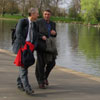Lichen Biomonitoring Protocol
 The method is adapted from Insarov (2002) to meet the additional requirements of an inter-city comparative study to record and
monitor lichen diversity and distribution in Moscow and London over a twenty-five year period.
The method is adapted from Insarov (2002) to meet the additional requirements of an inter-city comparative study to record and
monitor lichen diversity and distribution in Moscow and London over a twenty-five year period.
Changes in air pollution and climate over the period will also be documented to identify spatial and temporal trends.
A method for detecting long-term environmental change with lichens
- 1. Aim
- 2. Method
- 2.2. Site and plot selection
- 2.3. Tree selection and lichen sampling protocol
i. Prepare a standard lichen survey sheet. Record date, tree type and girth and global position. For roadside woodland-edges compass points for the woodland-edge faces should be recorded. Select mature trees with near vertical trunks, omitting trees with severe visible damage to bark or crown. Select trees without a priori information on presence and abundance of lichens. To exclude effects of tree age, trees should be of the same age and/or size 60 – 140 cm girth at 1.5 m.
ii. At a fixed height from the tree base (1.5m recommended) place a measuring tape around the tree in a clockwise direction from north (zero). Starting at 0, record beginning and end of all lichen thalli intersected by the upper edge of the measuring tape. Record cover as a linear distance occupied by each thallus. For fruticose lichens with branch width less than 1 mm note the number of branches crossing each millimetre on the scale (Insarov & Pchiolkin,1988).
iii. Record all lichens present on the trunk up to 2m, and record the total number of macrolichen thalli on the tree. Estimate Vitality Index (VI) for each species thalli: 1 = healthy (no bleaching or necrosis), 2 = slight necrosis (<30%), 3 = Moderate necrosis (>30% and <100%), 4 = Necrotic (100%). Use a simple percentage cover scale for crustose species: I= single thallus, II= < 25%, III= 25-75%, IV= >75% to full tree. Where extensive, continuous cover of foliose species is found (i.e. Physcia adscendens/tenella) the cover scale should be used if necessary. Note any signs of stemflow or other special features.
iv. Do not take any samples from the tape recorded areas and where chemical tests or sampling is essential remove the smallest possible specimen to ensure that the development of the lichen is not harmed. If the lichens are harmed the tree should not be included in the survey.
- 2.4. Data collection and handling
- 3. References
Go back to the Biomonitoring page.

